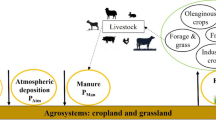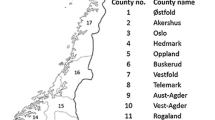Abstract
Given that phosphorus (P) is a non-renewable and finite resource, there is an increasing need to sustainably use P in agriculture. To this end, accurately assessing P budgets in agricultural soils is critical. On one hand P deficiency negatively affects plant and animal growth, while on the other hand P surplus can cause significant problems that affect water quality (e.g. eutrophication and low oxygen level). The method to estimate the Phosphorus Budget as proposed by Eurostat and the OECD was developed under the assumption of zero changes in soil P stock (SSC-P), due to the lack of available data. However, studies have shown that SSC-P cannot be neglected to assess P efficiency properly. In this study, an approach is proposed that allows estimating SSC-P, as well as related indicators. The largest uncertainty in the method derives from the lack of evidence on the maximum achievable Phosphorus Use Efficiency (PUEmax). The national and regional P budgets of agriculture in Turkey were estimated using the improved methodology at the level of administrative regions for the period 2007–2011. Results give a range of regional SSC-P of −4.8 and 3.9 kg P ha−1 year−1 with a mean national SSC-P of −0.3 kg P ha−1 year−1 (assuming a PUEmax of 100 %). However, the average SSC-P for Turkey could be as large as −1.4 kg P ha−1 year−1 for a PUEmax of 80 %.




Similar content being viewed by others
References
CAPRI (2013) CAPRI modelling system common agricultural policy regionalised impact modelling system. http://www.capri-model.org/dokuwiki/doku.php?id=capri:concept:nBal
Chien SH, Sikora FJ, Gilkes RJ, McLaughlin MJ (2012) Comparing of the difference and balance methods to calculate percent recovery of fertilizer phosphorus applied to soils: a critical discussion. Nutr Cycl Agroecosyst 92:1–8
Cross AF, Schlesing WH (1995) A literature review and evaluation of the Hedley fractionation: applications to the biogeochemical cycle of soil phosphorus in natural ecosystems. Geoderma 64(3–4):197–214
Djodjic F, Bergström L, Grant C (2005) Phosphorus management in balanced agricultural systems. Soil Use Manag 21:94–101
Eurostat (2013) Nutrient budgets, EU-27, NO, CH. Methodology and handbook. Version 1.02. Luxembourg, Eurostat
Eurostat (2015) Gross nutrient balance. http://appsso.eurostat.ec.europa.eu/nui/show.do?dataset=aei_pr_gnb&lang=en. Eurostat
GDWW (2015) Basin protection action final reports (in Turkish). http://suyonetimi2.ormansu.gov.tr/su/AnaSayfa/Havza_Yonetimi_Planlamasi_Daire-Baskanligi/HavzaKoruma.aspx?sflang=tr
Hansen NC, Daniel TC, Sharpley AN, Lemunyon JL (2002) The fate and transport of phosphorus in agricultural systems. J Soil Water Conserv 57:408–417
Ibrikci H, Ryan J, Ulger AC, Buyuk G, Cakir B, Korkmaz K, Karnez E, Ozgenturk G, Konuskan O (2005) Maintenance of phosphorus fertilizer and residual phosphorus effect on corn production. Nutr Cycl Agroecosyst 72:279–286
Johnston AE, Dawson CJ (2005) Phosphorus in agriculture and in relation to water quality. Peterborough, UK, Agricultural Industries Confederation
Johnston AE, Syers JK (2009) A new approach to assessing phosphorus use efficiency in agriculture. Better Crops 93(3):14–16
Johnston AE, Poulton PR, Fixen PE, Curtin D (2014) Phosphorus: its efficient use in agriculture, advances in agronomy, vol 123. Academic Press, Burlington, pp 177–228
Lassaletta L, Billen G, Grizzetti B, Anglade J, Garnier J (2014) 50 year trends in nitrogen use efficiency of world cropping systems: the relationship between yield and nitrogen input to cropland. Environ Res Lett 9:105011
Leip A, Britz W, Weiss F, de Vries W (2011) Farm, land, and soil nitrogen budgets for agriculture in Europe calculated with CAPRI. Environ Pollut 159:3243–3253. doi:10.1016/j.envpol.2011.01.040
MacDonald GK, Bennett EM, Potter PA, Ramankutty N (2011) Agronomic phosphorus imbalances across the world’s croplands. PNAS 108(7):3086–3091
Mahisarakul J, Siripaibool C, Claimon J, Pakkong P (2002) Field assessment of the relative agronomic effectiveness of phosphate rock materials in a soybean-maize crop rotation using 32P isotopic techniques. In: Assessment of soil phosphorus status and management of phosphatic fertilizers to optimize crop production. IAEA-TECDOC-1272, International Atomic Energy Agency (IAEA), Vienna, Austria, pp 265–274
Mathews BW, Hopkins KD (1999) Superiority of S-shaped (sigmoidal) yield curves for explaining low-level nitrogen and phosphorus fertilization responses in the humid tropics. J Hawaii Pac Agric 10:33–46
Moriasi DN, Arnold JG, Van Liew MW, Bingner RL, Harmel RD, Veith TL (2007) Model evaluation guidelines for systematic quantification of accuracy in watershed simulations. Trans ASABE 50(3):885–900
OECD (2001) Environmental indicators for agriculture: methods and results. OECD, Paris
OECD (2013) OECD Compendium of agri-environmental indicators. OECD Publishing, Paris. doi:10.1787/9789264186217-en
Overman AR, Scholtz RV (2002) Mathematical models of crop growth and yields. Marcel Dekker, New York
Ozbek FS (2014) Estimation of national and regional phosphorus budgets for agriculture in Turkey. Span J Agric Res 12(1):52–60. doi:10.5424/sjar/2014121-4327
Ozbek FS, Leip A (2015) Estimating the gross nitrogen budget under soil nitrogen stock changes: a case study for Turkey. Agric Ecosyst Environ 2(1):109
Ozturk L, Eker S, Torun B, Cakmak I (2005) Variation in P efficiency among 73 bread and durum wheat genotypes grown in a P-deficient calcareous soil. Plant Soil 269:69–80
Peñuelas P, Poulter B, Sardans J, Ciais P, Van der Velde M, Bopp L, Boucher O, Godderis Y, Hinsinger P, Llusia J, Nardin E, Vicca S, Obersteiner M, Janssens IA (2013) Human-induced nitrogen–phosphorus imbalances alter natural and managed ecosystems across the globe. Nat Commun 4(December):2934. doi:10.1038/ncomms3934
Sattari SZ, Bouwman AF, Giller KE, Van Ittersum MK (2012) Residual soil phosphorus as the missing piece in the global phosphorus crisis puzzle. Proc Natl Acad Sci USA 109(16):6348–6353. doi:10.1073/pnas.1113675109
Sharpley AN, Chapra SC, Wedepohl R, Sims JT, Daniel TC, Reddy KR (1994) Managing agricultural phosphorus for protection of surface waters: issues and options. J Environ Qual 23(3):437–451
Sims JT, Edwards AC, Schoumans OF, Simard RR (2000) Integrating soil phosphorus testing into environmentally based agricultural management practices. J Environ Qual 29:60–71
Smith VH (1998) Cultural eutrophication of inland, estuarine, and coastal waters. In: Pace ML, Groffman PM (eds) Successes, limitations, and frontiers in ecosystem science. Springer, New York
Syers K, Johnston E, Curtin D (2008) Efficiency of soil and fertilizer phosphorus use. FAO Fertilizer and Plant Nutrition Bulletin, Rome
TurkStat (2013) Foreign trade statistics. https://biruni.tuik.gov.tr/disticaretapp/menu_ing.zul. Accessed 15 Mar 13
White S, Cordell D, Moore D (2010) Securing a sustainable phosphorus future for Australia: implications of global phosphorus scarcity and possible solutions. Institute for Sustainable Futures, for CSIRO Sustainable Agriculture Flagship SENSE Earth Systems Governance, Amsterdam, 24th–31st August (2008)
Willcutts JF, Overman AR, Hochmuth GJ, Cantliffe DJ, Soundy P (1998) A comparison of three mathematical models of response to applied nitrogen: a case study using lettuce. Hort Sci 33:833–836 (Williams, G. P. 1997)
Zou X, Binkley D, Doxtader KG (1992) A new method for estimating gross phosphorus mineralization and immobilization rates in soils. Plant Soil 147(2):243–250
Author information
Authors and Affiliations
Corresponding author
Electronic supplementary material
Below is the link to the electronic supplementary material.
Rights and permissions
About this article
Cite this article
Özbek, F.Ş., Leip, A. & Van der Velde, M. Phosphorous stock changes in agricultural soils: a case study in Turkey. Nutr Cycl Agroecosyst 105, 51–59 (2016). https://doi.org/10.1007/s10705-016-9773-2
Received:
Accepted:
Published:
Issue Date:
DOI: https://doi.org/10.1007/s10705-016-9773-2




